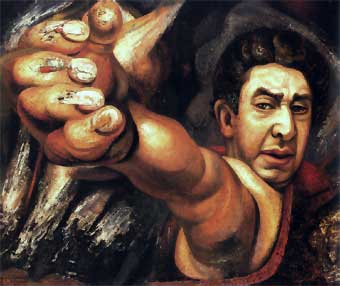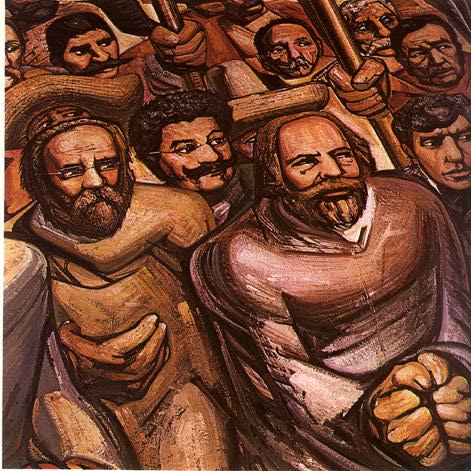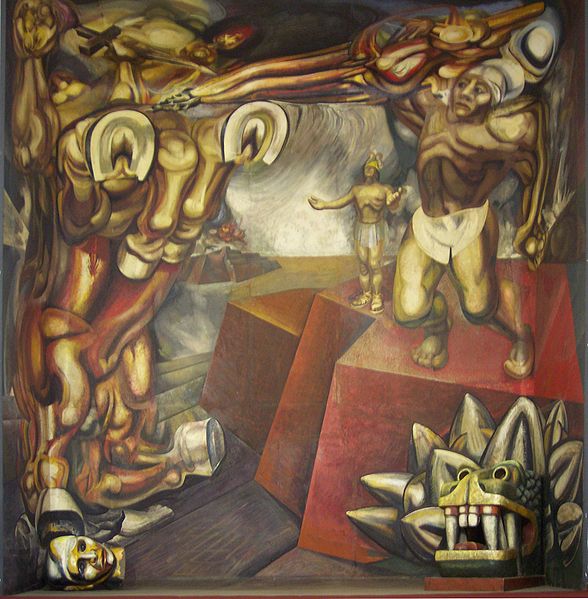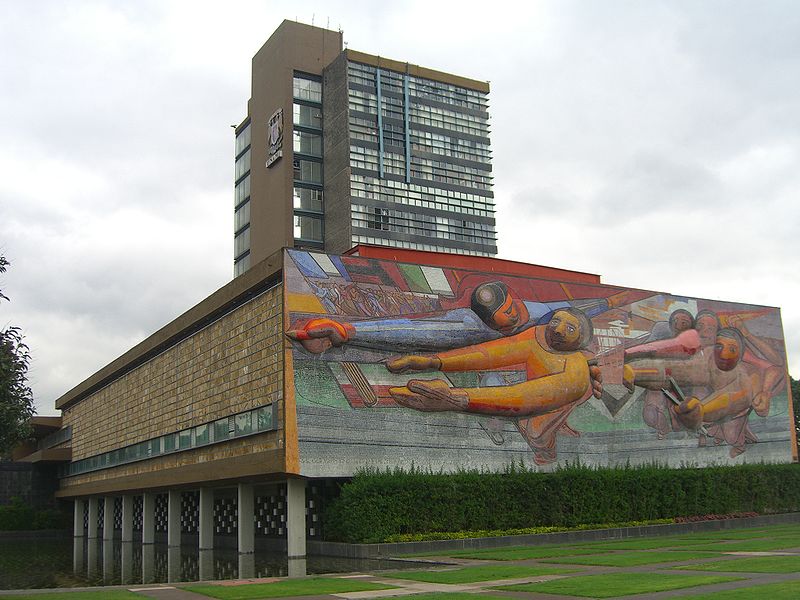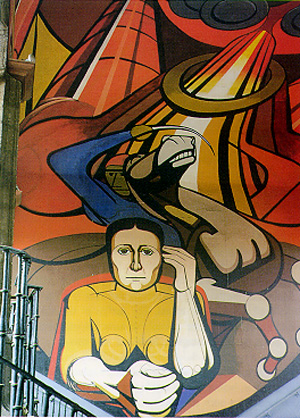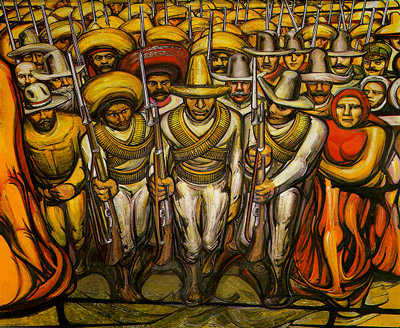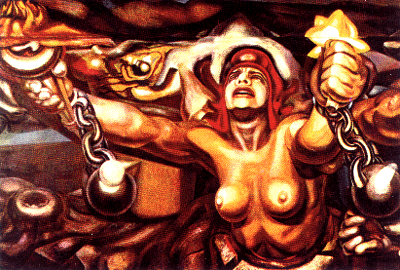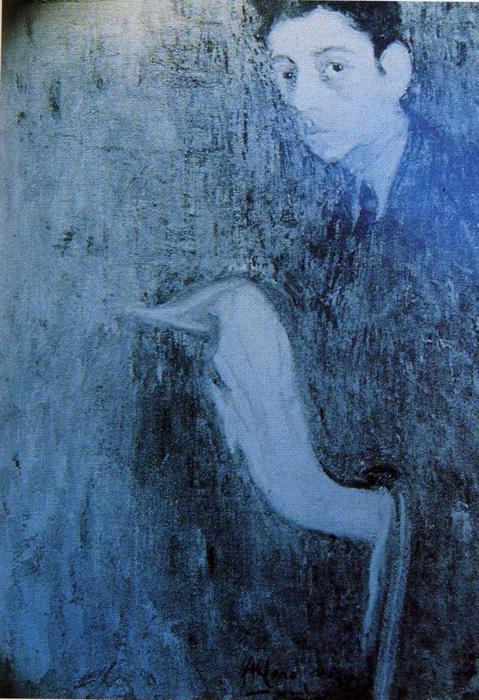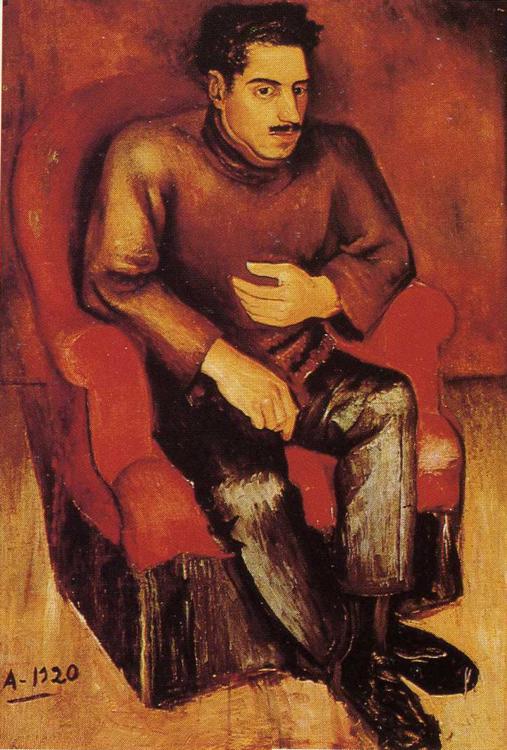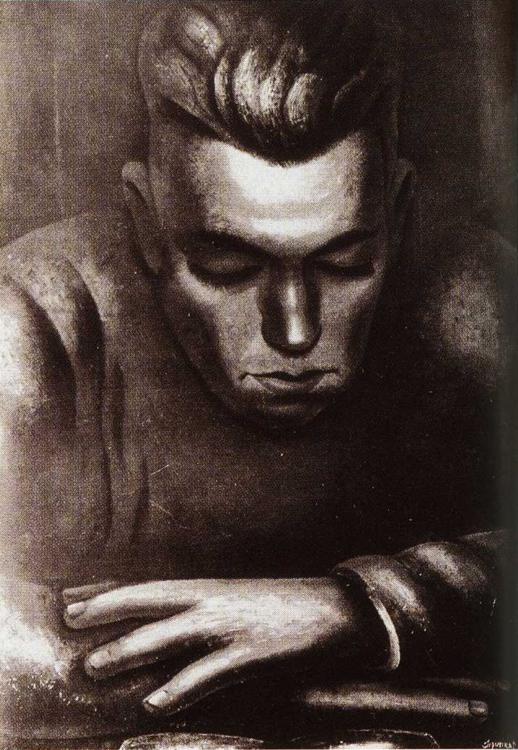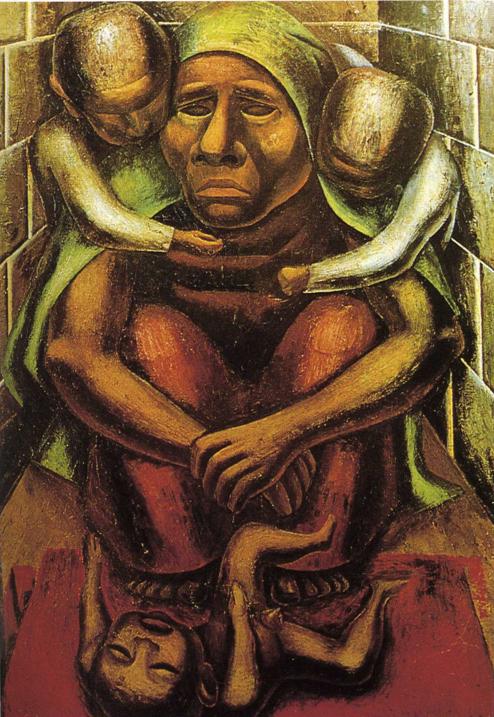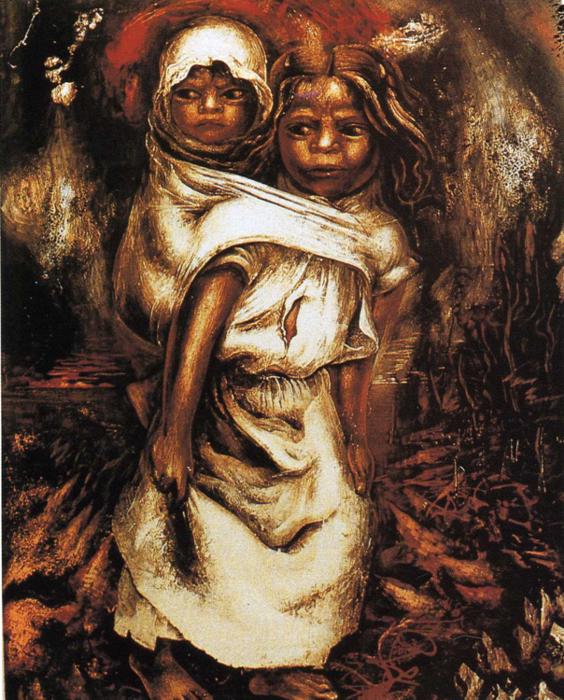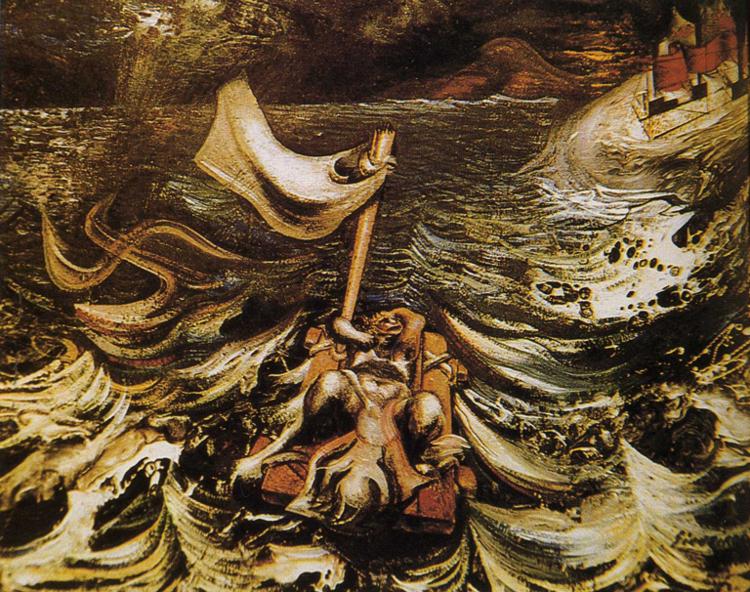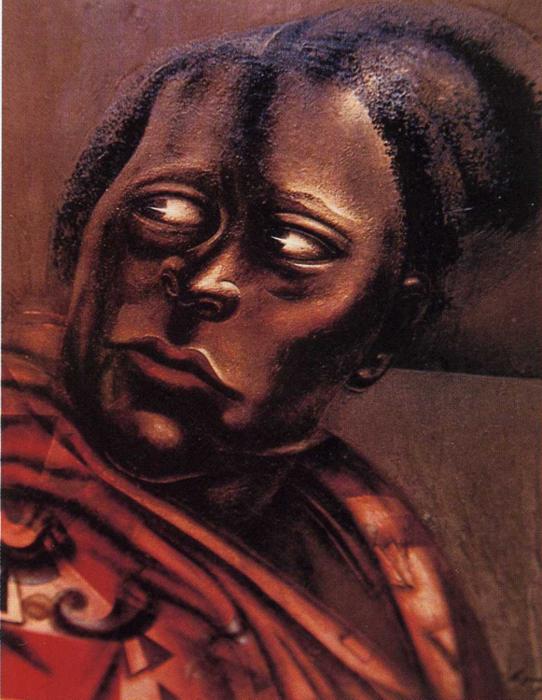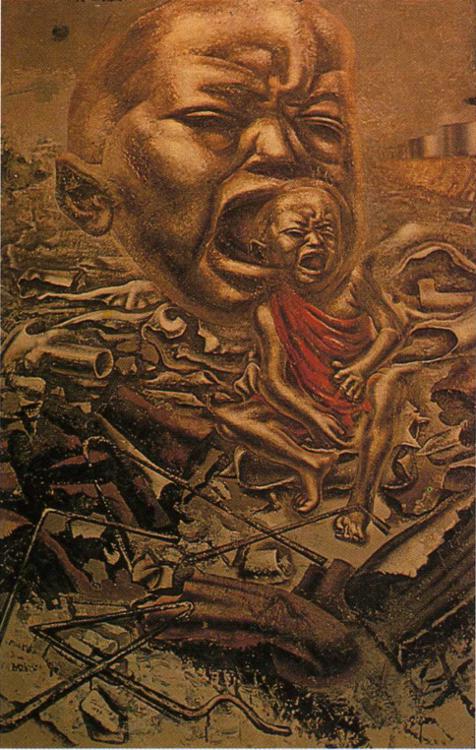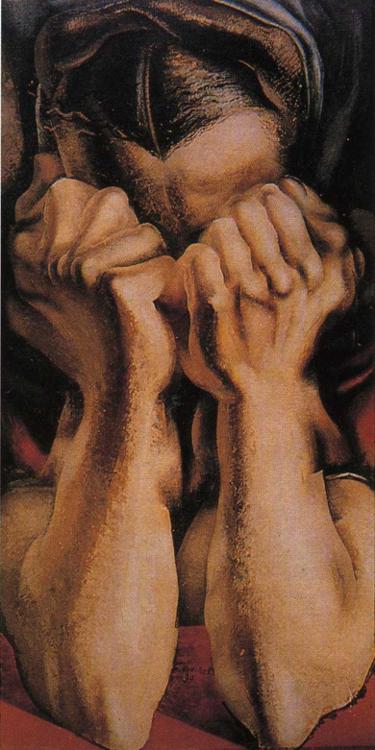<Back to Index>
- Mathematician Thomas Joannes Stieltjes, 1856
- Painter José David Alfaro Siqueiros, 1896
- 17th President of the United States Andrew Johnson, 1808
PAGE SPONSOR
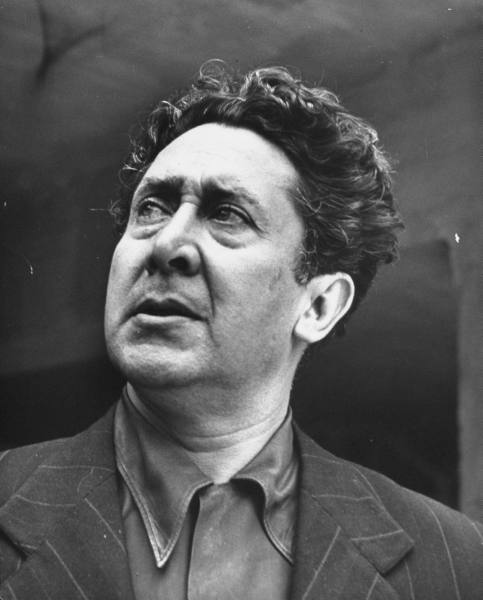
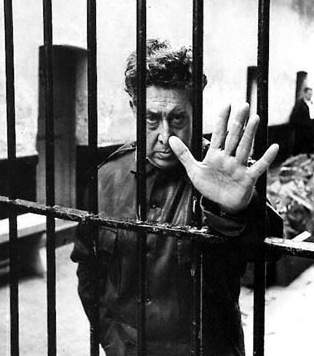
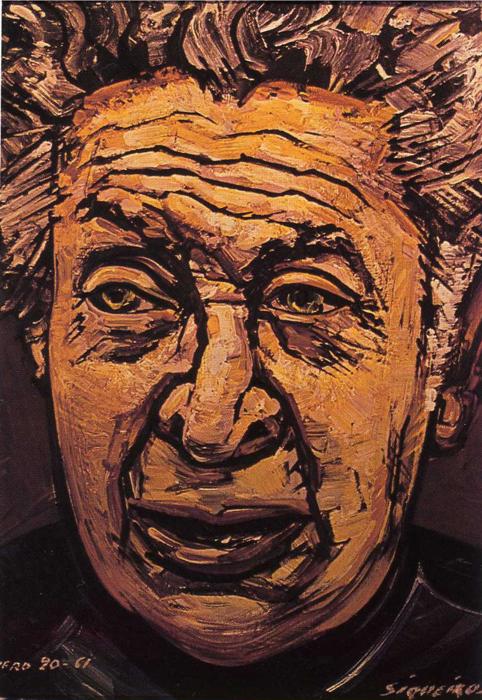
José David Alfaro Siqueiros (December 29, 1896, Camargo, Chihuahua, Mexico - January 6, 1974, Cuernavaca, Morelos, Mexico) was a social realist painter, known for his large murals in fresco that helped establish the Mexican Mural Renaissance, together with works by Diego Rivera and José Clemente Orozco, and also a Stalinist who participated in an unsuccessful attempt to assassinate Leon Trotsky in May 1940.
Siqueiros was born the second of three children in Chihuahua, Mexico, in 1896. His father, Cipriano Alfaro, was well-to-do, and was a descendant of Felipe Alfaro of Portugal. His mother, Teresa Siqueiros, came from a Chihuahua family of musicians, actors, and poets. Siqueiros had two siblings: a sister, Luz, three years older, and a brother Chucho, one year younger. David was four years old when his mother died and his father sent the children to live with their paternal grandparents. Siete Filos, David’s grandfather, would have an especially strong role in his upbringing. However, Cipriano, a devout Catholic, disapproved with the way that his parents had been raising the children in the countryside, so in 1907 he brought them back to live with him in Mexico City. There David attended a biblical school. He credits his first rebellious influence to his sister, who had resisted their father’s religious orthodoxy. Around this time, David was also exposed to new political ideas, mainly along the lines of anarcho-syndicalism. One such political theorist was Dr. Atl, who published a manifesto in 1906 calling for Mexican artists to develop a national art and look to ancient indigenous cultures for inspiration. In 1911 when he was only fifteen years old, Siqueiros was involved in a student strike at the Academy of San Carlos of the National Academy of Fine Arts that protested the school's method of teaching and urged the impeachment of the school's director. Their protests eventually led to the establishment of an “open-air academy” in Santa Anita.
At the age of eighteen, Siqueiros and several of his colleagues from the School of Fine Arts, joined Venustiano Carranza’s Constitutional Army fighting
the Huerta government. When Huerta fell in 1914, Siqueiros became
entrenched in the “post-revolutionary” infighting, as the
Constitutional Army had to battle the political factions of Pancho Villa and Emiliano Zapata for control. His
military travels around the country exposed him to Mexican culture and
the raw everyday struggles of the working and rural poor. After
Carranza’s forces had gained control, Siqueiros briefly returned to
Mexico City to paint before traveling to Europe in 1919. First in
Paris, he absorbed the influence of cubism, intrigued particularly with Paul Cézanne and the use of large blocks of intense color. While there, he also met Diego Rivera,
another Mexican painter in “the big three” just on the brink of a
legendary career in muralism, and traveled with him throughout Italy to
study the great fresco painters of the Renaissance. Although many have said that
Siqueiros' artistic ventures were frequently “interrupted” by his
political ones, Siqueiros himself believed the two were intricately
intertwined. By 1921, when he wrote his manifesto in Vida Americana, Siqueiros had already been exposed to Marxism and
saw the life of the working and rural poor while traveling with the
Constitutional Army. In "A New Direction for the New Generation of
American Painters and Sculptors," he called for a "spiritual renewal"
to simultaneously bring back the virtues of classical painting while
infusing this style with "new values" that acknowledge the “modern
machine” and the “contemporary aspects of daily life". The
manifesto also claimed that a "constructive spirit" is essential to
meaningful art, which rises above mere decoration or false, fantastical
themes. Through this style, Siqueiros hoped to create a style that
would bridge national and universal art. In his work as well as his
writing, Siqueiros sought a social realism that at once hailed the
proletariat peoples of Mexico and the world while avoiding the
clichés of trendy "Primitivism" and "Indianism". In 1922, Siqueiros returned to Mexico City to work as a muralist for Álvaro Obregón’s revolutionary government. Then Secretary of Public Education José Vasconcelos made
a mission of educating the masses through public art and hired scores
of artists and writers to build a modern Mexican culture. Siqueiros,
Rivera and Jose Orozco worked together under Vasconcelos, who supported
the muralist movement by commissioning murals for prominent buildings
in Mexico City. Still, the artists working at the Preparatoria realized
that many of their early works lacked the "public" nature envisioned in
their ideology. In 1923 Siqueiros helped found the Syndicate of
Revolutionary Mexican Painters, Sculptors and Engravers, which
addressed the problem of widespread public access through its union
paper, El Machete.
That year the paper published – "for the proletariat of the world" – a
manifesto, which Siqueiros helped author, on the necessity of a
"collective" art, which would serve as "ideological propaganda" to
educate the masses and overcome bourgeois, individualist art. Soon after, Siqueiros painted his famous mural Burial of a Worker (1923)
in the stairwell of the Colegio Chico. The fresco features an
indigenous woman mourning over a coffin, decorated with a hammer and
sickle. But
as the union became ever more critical of the revolutionary government,
which had not instituted the promised reforms, its members faced new
threats to cut funding for their art and the paper. A feud within the
union over whether to cease publishing El Machete or
lose financial support for the mural projects left Siqueiros at the
forefront, as Rivera left in protest of the decision to uphold politics
over artistic opportunity. Despite being let go from his post under the
Department of Education in 1925, Siqueiros remained deeply entrenched
in labor activities, in the union as well as the Mexican Communist
Party, until he was jailed and eventually exiled in the early 1930s. In
the early 1930s, including his time spent in the Mexican Lecumberri
Prison, Siqueiros produced a series of politically themed lithographs,
many of which were exhibited in the United States. His lithograph Head was shown at the 1930 exhibition “Mexican Artists and Artists of the Mexican School” at The Delphic Studios in New York City. In
1932, he led an exhibition and conference entitled “Rectifications on
Mexican Muralism” at the gallery of the Spanish Casino in Taxco, Mexico. Shortly
after, he traveled to New York, where he participated in the Weyhe
Gallery’s “Mexican Graphic Art” exhibition. With a team of students, he
also completed a mural, known sometimes as Tropical America, in 1932 at the Italian Hall at Olvera Street in Los Angeles. Painting
fresco on an outside wall – visible to passersby as well as intentional
viewers – forced Siqueiros to reconsider his methodology as a muralist.
He wanted the image – an image of an Indian peon being crucified by
American oppression – to be accessible from multiple angles. Instead of
just constructing “an enlarged easel painting,” He realized that the
mural “must conform to the normal transit of a spectator.” Eventually,
Siqueiros would develop a mural technique that involved tracing figures
onto a wall with an electric projector, photographing early wall
sketches to improve perspective, and new paints, spray guns, and other
tools to accommodate the surface of modern buildings and the outdoor
conditions. He was unceremoniously deported from the United States for
political activity the same year. Back
to New York in 1936, he was the guest of honor at the “Contemporary
Arts” exhibition at the St. Regis gallery. There he also ran a
political art workshop in preparation for the 1936 General Strike for
Peace and May Day parade. The young Jackson Pollock attended the workshop and helped build floats for the parade. Continuing to
produce several works throughout the late 1930s – such as Echo of a Scream (1937) and The Sob (1939),
both now at the Museum of Modern Art in New York – Siqueiros also led a
number of experimental art workshops for American students. He spent
the better part of 1938 with the Republican Army in Spain fighting
against Francisco Franco’s fascist dictatorship before returning to
Mexico City to work on a project for the electrician’s union. In a
stairwell of the Sindicato Mexicano de Electricistas, Siqueiros designed one of his most famous works, Portrait of the Bourgeoisie, warning against the duel foes of capitalism and fascism. The piece
shows these two forces operating as a single political machine,
swallowing workers to create wealth. Yet an armed, brave-faced
revolutionary, of unnamable class or ethnicity, dives into the scene to
rescue the workers, and a blue sky on the ceiling flanked by electrical
towers displays hope for the proletariat in technological and
industrial advances. Before the mural’s completion in 1940, however,
Siqueiros was forced into hiding and later jailed for his links to an
attempt to assassinate Leon Trotsky, then in exile in Mexico City from
the Soviet Union. Siqueiros
participated in the first ever Mexican contingent at the XXV Venice
Biennale exhibition with Orozco, Rivera and Tamayo in 1950, and he
received the second prize for all exhibitors, which recognized the
international status of Mexican art. Yet
by the 1950s, Siqueiros returned to accepting commissions from what he
considered a “progressive” Mexican state, rather than painting for galleries or private patrons. He painted an outdoor mural entitled The People to the University, the University to the People at the National Autonomous University of Mexico in Mexico City in 1952. In 1957 he began work on a 4,500-square-foot (420 m2) government commission for Chapultepec Castle in Mexico City; Del porfirismo a la Revolución was his biggest mural yet. (The painting is known in English as From the Dictatorship of Porfirio Diaz to the Revolution or The Revolution Against the Porfirian Dictatorship.) In
the lobby of the Hospital de la Raza in Mexico City, he created a
revolutionary multi-angular mural using new materials and techniques,
"For the Social Welfare of all Mexicans." After painting "Man the
Master and Not the Slave of Technology" on a concave aluminum panel in
the lobby of the Polytechnic Institute, he painted "The Apology for the
Future Victory of Science over Cancer" on panels which wrap around the
lobby of cancer center. Yet
near the end of the decade, his outspoken political ideas and
activities alienated him from the government as well as the general
public. Under pressure from the government, the National Actors’
Association, which had commissioned a mural on the theater in Mexico
suspended his work on The History of Theater in Mexico at the Jorge Negrete Theater and sued him for breach of contract in 1958. Siqueiros
was eventually arrested in 1960 for openly attacking the President of
Mexico and leading protests against the arrests of striking workers and
teachers, though the charges were commonly known to be false. Numerous protests ensued, even including an appeal by well-known artists and writers in a New York Times ad in 1961. Unjustly imprisoned, Siqueiros continued to paint, and his works continued to sell. During that stay, he would make numerous sketches for the project of decorating the Hotel Casino de la Selva, owned by Manuel Suarez y Suarez.
Siqueiros was finally released in spring of 1964 and immediately
resumed work on his suspended murals in the Actors' Union and
Chapultepec Castle. When
the mural planned for the Hotel de la Selva in Cuernavaca was moved to
Mexico City and expanded, he assembled a team of national and
international artists to work on the panels in his workshop in
Cuernavaca. This
project, his last major mural, is the largest mural ever painted, an
integrated structure combining architecture, in which the building was
designed as a mural, with mural painting and polychromed sculpture.
Known as the Polyforum Siqueiros, the exterior consists of 12 panels of
sculpture and painting while the walls and ceiling of the interior are
covered with "The March of Humanity on Earth and Toward the Cosmos." Completed in 1971 after years of extension and delay, the mural broke from some
previous stylistic mandates, if only by its complex message. Known for
making art that was easily read by the public, especially the lower
classes, Siqueiros message in The March is more difficult to decipher,
though it seems to fuse two visions of human progress, one
international and one based in Mexican heritage. The
mural’s placement at a ritzy hotel and commission by its millionaire
owner also seems to challenge Siqueiros’ anti-capitalist ideology. As
a muralist, and an artist Siqueiros believed art should be public,
educational, and ideological. He painted mostly murals and other
portraits of the revolution – its goals, its past, and the current
oppression of the working classes. Because he was painting a story of
human struggle to overcome authoritarian, capitalist rule, he painted
the everyday people ideally involved in this struggle. Though his
pieces sometimes include landscapes or figures of Mexican history and
mythology, these elements often appear as mere accessories to the story
of a revolutionary hero or heroes (several works depict the
revolutionary "masses," such as the mural at Chapultepec). His
interest in the human form developed at the Academy in Mexico City. His
accentuation of the angles of the body, its muscles and joints, can be
seen throughout his career in his portrayal of the strong revolutionary
body. In addition, many works, especially in the 1930s, prominently
feature hands, which could be interpreted as another heroic symbol of
proletarian strength through work: his self portrait in prison (El Coronelazo, 1945, Museum of Modern Art, Mexico City), Our Present Image (1947, Museum of Modern Art, Mexico), New Democracy (1944, Palace of Fine Arts, Mexico City), and even his series on working class women, such as The Sob.
